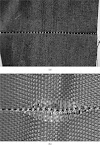CSV (Centre to Selvedge Variation)
CSV is one of the fabric inspection method which is carried out in a apparel industries. Centre to selvedge variation (CSV) itself states that it shows the variations which found in between centre of the fabric and selvedge (edge) of the fabric. CSV is one of the inspection procedure which every organisation need to be conduct. CSV inspection is very important related to marker planning as this kind of variation may cause loss of fabric. As the variations go beyond certain level decided by the buyer, the fabric lot is rejected and is send back to the manufacturer.
• Under CSV we inspect –
1. Centre to selvedge width length
2. Centre to selvedge shade variation
• Procedure to conduct width length inspection –
1. Take the fabric roll and load on the inspection table.
2. Start unrolling the fabric and take it to the inspection side.
3. Start measuring the width of the fabric as fabric starts unrolling.
4. Note down the readings of the width after every 50 meters. (This may change as per regulations of organisations).
5. After the inspection examine the results and check for acceptance of the fabric.
6. When fabric is accepted but having little variation, then marker planning must be done accordingly to the lowest width found throughout the fabric.
7. This is done because when lays are going to be formed, their should not be any lay missed while cutting.
E.g. A fabric having width variations as 38”, 36.5”, 37”. Then pattern maker must make maker plan according to the 36.5” for the whole roll of fabric.
8. By doing this every lay will include in while cutting but the fabric wastage will be more.
• Procedure to conduct shade variation –
1. To check the shade variation, cut a strip of fabric width wise with height of around 15-20 cm from start, mid and end of the fabric roll.
Let following is the width wise strip of a fabric roll with selvedge at the both edge.
2. Now take one strip and cut it into 4 equal parts and number it as 1, 2 , 3 and 4.
3. Further take piece of number 1 and 3 together and 2 and 4 together.
4. Now check for the shade variation under good light source.
5. If their is no variations, fabric is acceptable but if their is more variation then fabric must be rejected.
6. If their are minor variations, fabric may be accepted and precautions will be taken during marker planning, so that same shade patterns will come together.
Picture source-https://www.textilemerchandise.com













1 Comments
panioKpulcsu Chris Swindle https://wakelet.com/wake/c0cG1eBTVKmf3S54fMAVe
ReplyDeletenoliryma
If you have any doubts, please don't hesitate to ask